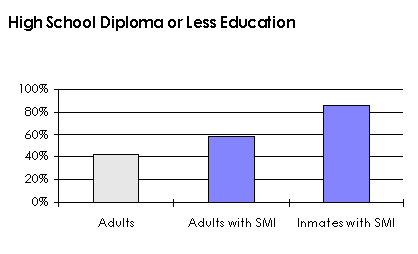
A brief look at selected demographic indicators demonstrates that consumers of state supported mental health services exhibit important distinctions in key life domains compared to Alaskans as a whole. Some items in particular stand out.
· Children and adolescents are over-represented in the mental health consumer population compared to the population as a whole. For example, children ages 6 through 17 make up about 21% of Alaska's population. They represent over 30% of community mental health center mental health consumer admissions and 33% of Medicaid beneficiaries. On the other hand, Alaskans over age 60 account for over 7% of the state's population, but less than 2% of community mental health center and Alaska Psychiatric Institute admissions.
· Mental health consumer gender composition does not match that of the state population. Males outnumber females in Alaska for all population cohorts under age 60. Females represent about 47% of the 22 to 59 cohort at large, but 60% of community mental health center admissions and over 73% of Medicaid clients. Males are over-represented for ages 6 through 17.
· The racial make-up of the mental health consumer population also differs from that of Alaska at large (see Chart 4). Alaska Natives and Native Americans make up about one-sixth of the entire population, but much larger segments of mental health consumer samples-32% of under age 22 community mental health center admissions; 30% of under age 22 Alaska Psychiatric Institute admissions; 25% of under 22 Medicaid clients. Similar numbers hold true for adults, for example, 30% of mental health consumers in correctional institutions are Native Alaskans or Native Americans.
There are some important differences between the circumstances and achievements of mental health consumers and Alaskans as a whole as well.
Chart 4

· Alaska's 1996 median household income was about $48,000. Consumers of state supported mental health services earned substantially less. Over 80% of people admitted to community mental health centers report incomes under $40,000. The same held true for under age 22 Alaska Psychiatric Institute admissions. Household income for over 90% of age 22 and older API admissions was less than $20,000.
Chart 5
· Consumers of state supported mental health services' educational attainment lags behind that of other Alaskans as well, as shown in Chart 5. Nearly 58% of adult mental health consumers progressed no further than a high school diploma, compared to 42% of all Alaskan adults. Half of adult Alaskans have some college or an undergraduate degree; only 28% of mental health consumers do. Educational attainment for Department of Corrections' mentally ill offenders was strikingly limited-48% do not possess a high school diploma and another 38% have not advanced beyond high school.
Consumers of state supported mental health services' educational attainment lags behind that of other Alaskans as well, as shown in Chart 5. Nearly 58% of adult mental health consumers progressed no further than a high school diploma, compared to 42% of all Alaskan adults. Half of adult Alaskans have some college or an undergraduate degree; only 28% of mental health consumers do. Educational attainment for Department of Corrections' mentally ill offenders was strikingly limited-48% do not possess a high school diploma and another 38% have not advanced beyond high school.
· Mental health consumers are less likely to work than are other Alaskans. About two-thirds of Alaskans over age 16 work. Only one-fourth of adult mental health consumers admitted to community mental health centers are employed full-time and 13% report part-time or subsistence/seasonal work. About one-tenth reported they were unable to work. Alaska Psychiatric Institute patients, reflecting the more serious nature of their illnesses, are much more likely to be unemployed (nearly 40%) and unable to work (almost 43%).
· About 60% of adult community mental health center admissions were single, divorced or separated, compared to only 29% that were married. Three-fourths of Alaska Psychiatric Institute patients were single, separated, or divorced and only 18% married. Only 15% of mentally ill offenders in correctional institutions are married.
· Information concerning living situations is available for community mental health center and Alaska Psychiatric Institute admissions. Most CMHC child and adolescent mental health consumers live with relatives, but about 7% are in foster care situations. More than twice that percentage of API adolescent admissions come from foster care. In addition, over 8% of API adolescent patients list jail or correctional institutions as their immediate prior living circumstance. A similar number of adolescents entered Alaska Psychiatric Institute from crisis/respite facilities. The most common living situation for adults is with relatives (about half). Under 4% of adult community mental health center admissions are homeless. The homeless population at API is larger, more than 5% of adolescents and about 13% of adults.
The data show clearly that consumers of state supported mental health services lead different lives than other Alaskans. Employment, living situation, income, domestic relations, ethnic composition, and educational attainment-the standards and conditions of the Alaskan mental health consumer population all differ markedly from those of the larger population.